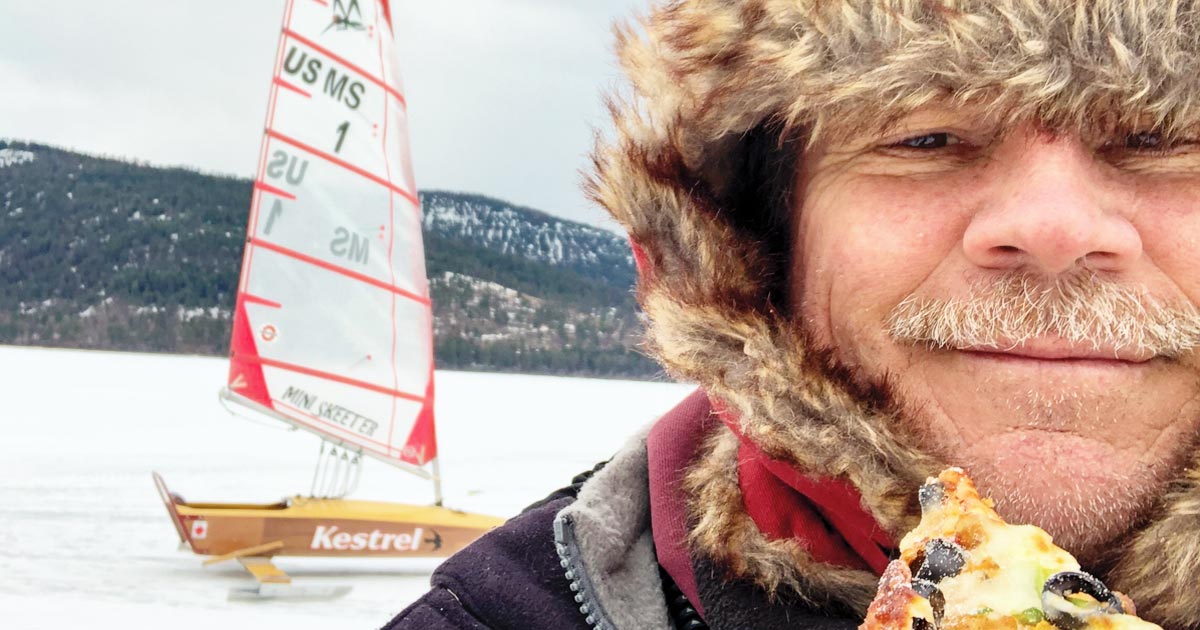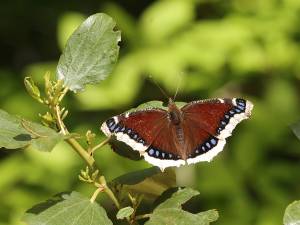Contains affiliate links
Euphoria fills John Eisenlohr whenever and wherever he goes ice sailing on Montana’s renowned frozen reservoirs from December to April.
Lying on his back, ensconced in a thin bullet-shaped hull perched on three metal runners, he zooms along at 40 to 70 miles an hour, at one with the wind and ice and the lightweight wooden craft he designed and built. Sometimes, he seems to levitate when a runner lifts from the ice at a curve or from an unexpected wind gust.
“It’s playing with nature, you take what it gives, and when the elements come together—the wind and the ice—it’s magical, and you’re totally in the moment,” Eisenlohr said of navigating his Mini Skeeter boat. “All you hear is the wind and the blades on the ice.”
During his fortuitous fast and furious days, he said adrenalin keeps him warm, along with layers of clothes, helmet and gloves.
For ice sailors like Eisenlohr, Montana’s high desert reservoirs are a destination. The meccas are Canyon Ferry, 25 miles southeast of Helena, and Fort Peck near Glasgow, where frigid temperatures coupled with lack of snow, create ideal ice and a nearly frictionless surface to test personal speed records.
Not wanting to keep a good thing to himself, Eisenlohr shares his love of ice sailing on YouTube, sells his boat plans nationwide and worldwide, and teaches a 13-part boat-building seminar at his cabinet shop at Lakeside near Flathead Lake.
Since 2008 when he established his YouTube channel, US772, he has had 1.2 million views. Naming his channel was easy. It is his registration number with the North American Land Sailing Association. He serves as the organization’s vice president.
Via videos, Eisenlohr takes viewers on vicarious rides with him, his brother, and nephew, and a convivial cadre of other hardcore ice sailors, Dave Gluek of Bozeman and Dave Farmer of Flathead Lake and Washington.
Known for his understanding of complex aerodynamics of boat design and his navigational expertise, Eisenlohr has sold 165 plans for his wooden boat, the Mini Skeeter, which he designed and built in 2014.
“My sail number is MS 1, since it was the first to be made,” Eisenlohr said.
The boat, weighing about 175 pounds, sets up quickly and is 8-feet wide, 13-feet long, and has a 5.5-square-meter sail. It looks like a snug cocoon that rests on three runners. The hull attaches to a perpendicular cross piece called a runner plank. Three skates, or runners, are affixed to the boat, one at the front and the two others on each end of the plank.
Eisenlohr designed the Mini Skeeter so its metal runners could swap out for wheels, enabling sailors to race on dry lake beds in spring and summer. Eisenlohr, his brother Scott, and nephew Will, along with Gluek and Farmer, are known in sailing circles for their year-round, title-winning addiction to sailing on any surface—ice, water, and land.
In a photo taken at the 2022 America’s Landsailing Cup (ALC) in the Mini Skeeter class, the Montanans grin as they cradle their trophies after racing across Ivanpah Dry Lake California in the Mojave Desert on the Nevada/California border near Primm, Nev. John Eisenlohr placed first, Gluek second, Farmer third, Scott Eisenlohr fourth, and Will Eisenlohr fifth.
Since Eisenlohr built his Mini Skeeter, a new racing class was established for it. It has grown so popular that it is the second largest class in NALSA with 20 Mini Skeeter pilots competing last year at the ALC, the largest competition of its kind nationwide.
Eisenlohr is among the world’s best sailors. In 2014, he won the 14th Landsailing World Championship in the 5.6 Mini Yacht class at a remote site in Northern Nevada.
Sail-World reporter Russ Foster wrote, “Eisenlohr’s yacht features parts he found at local home supply stores, not purpose-built marine hardware. He is doing a great job of showing that a home builder with innovative ideas and excellent sailing skills can still do well against exotic professionally-developed machinery sailed by highly skilled international sailors.”
Sailors Since Childhood
Eisenlohr, Gluek, and Farmer all learned to sail in childhood—Eisenlohr in southern California under the tutelage of his renowned boat-building father and Gluek and Farmer on Lake Minnetonka in Minnesota. They are naturally hardwired to ride the wind—sailing is as second-nature to the trio as breathing.
For them, Canyon Ferry is centrally located, making it an ideal place to meet when the ice is right. Gluek, 68, a retired Bozeman realtor and self-described “full-time recreationalist,” lives about 75 miles from Canyon Ferry. When ice isn’t suitable on Flathead Lake or other lakes in the valley, Eisenlohr, 60, drives 207 miles to Canyon Ferry. Farmer, 70, who retired five years ago from his vintage lighting and restoration business in Spokane, Wash., comes down from his cabin on Flathead Lake or drives 350 miles from his home in TumTum, Wash., to be at Canyon Ferry.
“We sail other lakes in the Flathead Valley more than Flathead Lake itself, which is so large it rarely freezes over completely,” Farmer said. “Some years, we can sail some sheltered bays that freeze.”
Eisenlohr said he and Farmer and a band of other sailors travel to Canyon Ferry, Fort Peck, and Freezeout near Choteau to find suitable ice boating conditions when their local areas are not sail-able, or for special events.
Gluek, who sails 15 to 20 days a season, said it’s not the speed and accompanying adrenalin that lures him to the ice.
“For me, ice boating is not about how fast you go,” he said. “It’s a relationship between the boat, the wind, and the ice. Tacking upwind or jibing downwind is exhilarating for any sailor.”
In contrast, Farmer said, for him, ice sailing is all about speed.
“I’m an adrenalin junkie, someone who chases adventure, so I like to sail on the edge of control,” he said. “In an ice boat, depending on the wind, you can go three to five times the speed of the wind because there’s minimal friction on ice. So a 10-mile-an-hour wind could push you to 30 in a few seconds.”
For three days in early December at Canyon Ferry, Farmer had his adrenalin fix. “The winds were really big,” he said with satisfaction. “Some people don’t realize the ice can still be spectacular in spring, when temperatures are in the 40s. There might be standing water atop the ice with warm weather melting, but with 12 or more inches of solid ice below, the surface and the sailing can be excellent. We don’t always have to sail in cold weather.”
Launching the Sport in Montana
The modern sailors pay homage to hardy Montana pioneers who launched the sport statewide. For centuries, ice boating had been a popular recreational pastime in Europe and the East Coast of the United States, as well as a fast way to transport food and supplies.
Ice boats’ popularity spread to the Midwest during the Depression when the Detroit Free Press sponsored a contest for a father/son team to design a fast ice boat as family entertainment. The sails of the winning boat style still bear the newspaper’s DN logo, and the International DN Ice Yacht Racing Association was established.
In Montana, photos from the 1920s show ice sailors from the Kalispell area skimming across Flathead Lake. According to Eisenlohr, about 50 after that, Choteau farmers formed the Teton Ice Boat Club and sailed on nearby reservoirs, Eisenlohr said.
Gluek sailed with Canyon Ferry’s father of ice boating, the late Carl Harper.
A rancher and boat builder, Harper constructed his first ice boat from corral poles, salvaged plywood, and an old sail he cut to fit. He painted it John Deere green. It was known as the little green boat.
Harper was farming near Lennup, Mont., when he saw a newspaper photo of someone ice sailing on Freezeout Lake near Great Falls. He learned who it was, and they became lifelong friends. Harper, a member of the Canyon Ferry Yacht Club, was crucial in bringing ice boating and scow sailing to the lake.
Eisenlohr, Gluek, and Farmer are honoring the early sailors’ legacy and making Montana nationally renowned. In 2020, the popular International DN Ice Yacht Racing Association North American Championships were hosted for the first time at Fort Peck Reservoir because snow blanketed the usual racing sites in the Midwest, making them unsuitable.
On social media, competitors at the 2020 races raved about the reservoir’s 350 square miles of black ice. Eisenlohr posted a video on YouTube of the trio racing there. Some ice sailors from the Midwest were so impressed, they returned in 2021 to have informal races.
To know where the best ice is, ice sailors refer to a public Facebook forum, Montana Icebuds, to decide where to go.
“You never know when or where the conditions will be right, but we’re always ready to go when they are,” Eisenlohr said.
Come sail away …
Ice sailors invite the curious to meet them at Canyon Ferry Reservoir. They are based at the boat launch 7-½ miles north of Townsend. Follow Silos Road until it branches, take the fork to the right, and follow the signs to the boat launch and picnic shelter. If you can’t make it there, take a vicarious ride aboard an iceboat at John’s YouTube channel, US772. Iceboat.org also answers numerous questions about the speedy sport. MSN









